A Kitchen in France
by mimithorisson
Anatomy of a house
St Yzans is a quiet little village perched on a small hill in the middle of vineyards. Is has a big church, a small school, a Citroën garage and one little shop that is also a café. In the morning a white car delivers baguette to those who want it, maybe not the best baguette in France but a charming feature nonetheless. The village is so small that if you walk any street, in any direction for a few minutes you’ll find yourself amongst the vines. One of those streets is my street, rue de Loudenne. House number one on that street is an L-shaped old stone house with countless rooms and vast corridors. It’s been empty for years, safe for a few rooms that were inhabited by the previous owner’s mother. Everything else remains untouched, no weird renovations and less favorably, not much restoration.
My first love in this house is the old staircase, so grand, so beautiful that I would have settled for only that. I remember walking through the front door for the first time in late January this year, then standing still for a few moments, imagining my children running up and down the stairs, followed by dogs, of course. I imagined myself walking down the stairs on a festive evening wearing a long, elegant, flowing dress, followed by dogs, of course. Next to the staircase is the kitchen and I imagined persons of the past streaming in and out of the door, holding silver trays with delicious food, carrying them up the stairs and into the other wing where guests would dine under crystal chandeliers. Maybe they are still carrying trays up and down, who knows, in any case the house has been idle for so long I am sure the ghosts are happy to have some company.
Next to the kitchen on the first floor is a room, then another, and then a bigger room, the harvest room, which will be the principal room for my cooking workshops and restaurant. That room has an old staircase and under it, another kitchen, smaller, more rustic – even prettier than the first. In a few weeks or months all these rooms will be filled with food. They will be filled with bistrot chairs and simple tables, with mountains of fresh vegetables and fruits, with birds and hams and sausages hanging from the ceilings. Chests and cupboards will be overflowing with silverware and white cotton napkins and tablecloths. In one corner of one of the rooms will be the prettiest pine-wood cupboard that reaches from floor to ceiling – that’s where we’ll keep the tableware.
Outside the harvest room we have just planted a nicely sized olive tree with thousands of shiny black olives and next to it a few smaller ones. It makes me happy to think that next summer guests can dine in the shade of that tree and on rainy days we’ll leave the dining room doors open so everyone can enjoy the comforting sight of summer rain showering the garden.
Right now the only room that’s ready, and it isn’t REALLY ready, is the kitchen. Though we haven’t moved in yet we have already had several meals in there, to try it out, and mainly just because I adore being there. Everytime I leave I feel sad, if it wasn’t for my big family I think I might just sleep there on those red and cream kitchen floor tiles.
When we first made an offer for the house we found out that it was once owned by a formidable lady called Plantia Pautard. She always wore black dresses and she loved to cook. This much I knew, but the last few months have seen me piecing together little bits of information, old photographs, documents and declarations. But what did she like to cook? Everytime I run into someone elderly in the village, someone who might have known her I am all over them like a hawk. Luckily they are all happy to share. So far I’ve found out that she loved to make coq au vin. I discovered that blanquette de veau was her absolute signature dish, a recipe she reserved for special occasions. Last week I ran into an older man in the village who remembers her from the time he was a little boy. He used to bring her fava beans from his parent’s garden and he told me she used to scold him if they were too small. She like them big for her favorite soup which just happens to be my favorite soup too. Everyone remembers something about her cooking.
I believe in coincidences but I also believe in fate. So far everything Plantia liked I like too. In fact I like it so much that it’s all in my cookbook “A Kitchen in France”. And from now on I’ll be cooking them in her old kitchen in France.
As I said there are coincidences … and then there is fate.
Recipe testing – afterwards
The kids are just as excited as I am about my cookbook, but for different reasons perhaps. Louise has been counting the photos of herself and while she’s not unhappy about her grand total she’s a bit bothered by the fact that the biggest photo is of her brother and main rival, Hudson. He in turn is more of a worrier and asked me lately if I was sure that all the recipes worked. “Of course they do”, I answered “You have my food every day – don’t you like it?” “Yes I know YOU can do them but maybe they printed something wrong and everybody will be angry” he said. So he decided to try one and insisted that he would choose it himself. He’s been very interested in wine since we decided to make our own and though he was initially leaning towards the chocolate meringues he decided to go for the Médocain Pears drenched in wine. I promised to help, but not too much. My new fireplace, complete with a 650-kg iron sculpture is just screaming to be used so this week I kept my promise to the restoration guys and cooked them an entrecôte (rib-eye steak) feast with shallots and bone marrow – also from the book. Call me crazy, delusional even but everything seems so easy in that kitchen, everything just falls into place. It’s as if all the cooking that happened there once upon a time is simply waiting to happen all over again.
And for those of you who are wondering what we were doing driving around vineyards in a flag colored 2CV – here’s the explanation: It belongs to a friend who lent it to us for some filming we were doing last week and Oddur just can’t bear to give it up (even if he has problems starting it). Driving around in the French countryside in an old Citroën, with just a few baguettes and a piece of Camembert is not the worst way to spend a chilly November afternoon.
On a practical note so many of you have been in touch and shown interest in my upcoming cooking workshops. We are still working out the finer details, prices, duration etc but I am thrilled to announce that we will start on the 17th of March 2015. We decided not to wait until the guest rooms are ready and have found some great places to stay for those of you attending the first classes.
So for those of you who are really interested and who are able to come in March please don’t hesitate to contact me – that first class will be a special one.
Next week, we will be in New York! I will be hosting two book signing events, one at Kisan (125 Greene Street/Soho) on Wednesday, November 19 from 6:00-7:30pm & another one on Thursday, November 20th at Strand Bookstore @ Club Monaco (160 5th Avenue/Flatiron district) from 12:00-1:30pm. I am expecting you… see you there! Beyond excited. Mimi x
A KITCHEN IN FRANCE, A Year of Cooking in My Farmhouse
Published by Clarkson Potter / Random House available for sale on
Amazon – B&N – Indiebound and in bookstores.
Recipes from my book “A Kitchen in France”.
Grilled entrecôte à la Bordelaise
A big juicy entrecôte, or rib-eye steak, seasoned with just salt and pepper and cooked over high heat until crusty and juicy, has always had a special place in my heart. Frankly I didn’t think it could be improved on—that is until I moved to Médoc. As you will be well aware of at this point, the people of Bordeaux love adding shallots to everything. Here they work wonders and really complement the flavors of the meat. Add a bit of bone marrow ,and you are in meat heaven. It’s fine to cook this entrecôte on a regular grill but if you want the full Bordelaise effect, I recommend adding dried grapevines to the fire so that a hint of Cabernet or Merlot finds its way into your steak. Having this dish without a glass of red wine is a crime!
Serves 2
4 beef marrow bones
One 1-pound/ 400- to 500-g rib-eye steak
Fine sea salt and freshly ground black pepper
6 shallots, finely chopped
Prepare the oven to 400°F/ 200°C
To remove the marrow from the bones, put the bones in a baking dish and bake until the marrow is soft enough to scrape out of the bones, 10 to 15 minutes.
Prepare a medium-hot fire in the grill. You can add dried grapevines, if desired (to increase the smoky flavor).
Season the meat with salt and pepper. Grill the meat until browned and cooked to medium-rare, 3 to 4 minutes per side.
Heat the blade of a knife over the grill and spread the bone marrow over the meat. Sprinkle the shallots all over. Remove from the grill and serve immediately.
Pears à la Médocaine
I love having pears on my kitchen table; they age gracefully, the full colors come out, and they never taste better than just before they go bad. I usually try to catch them just at that moment and put them in a cake or tart or simply have them with some nuts, cheese and a glass of wine. It won’t surprise you that here in Bordeaux they like to drench pears in wine, which makes them very tasty and breathtakingly beautiful. If I were a painter, this is the dish I would paint first. Then I would eat it. (Actually, because I’m such an impatient gourmet, I would probably eat the pears first and then paint them from memory.)
Serves 6 to 8
3 cups/ 750 ml dry red wine
1 3/4 cups/ 350 g graduated sugar
1/2 vanilla bean, split lengthwise, seeds scraped out, seeds and beans reserved
1 cinnamon stick
2 bay leaves
2 star anise
6 to 8 large pears, peeled but stem left on
In a saucepan large enough to hold the pears standing upright, combine the wine, sugar, vanilla bean and seeds, cinnamon, bay leaves, and star anise, mix well, stirring to dissolve the sugar, and bring to a low boil over medium heat. Add the pears, stems up, cover, and simmer, turning the pears occasionally so they cook evenly, until they are tender, 30 minutes.
Let the pears cool, then refrigerate for 24 hours in the syrup. To serve, divide the pears among shallow bowls and spoon some of their syrup over them.

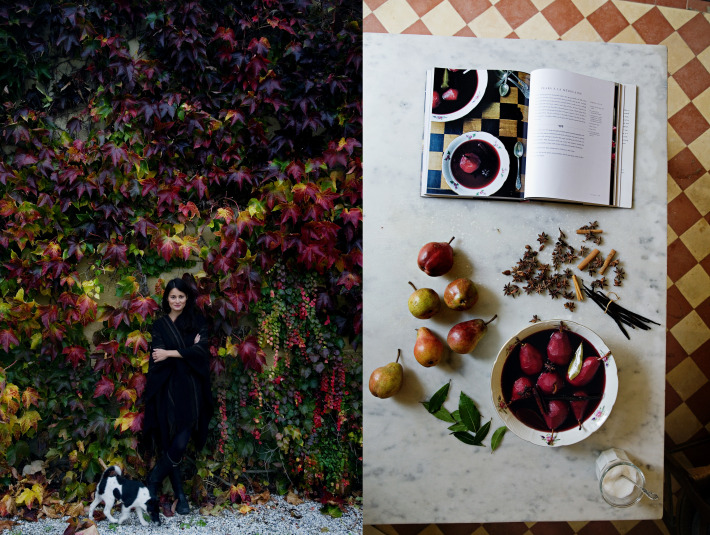
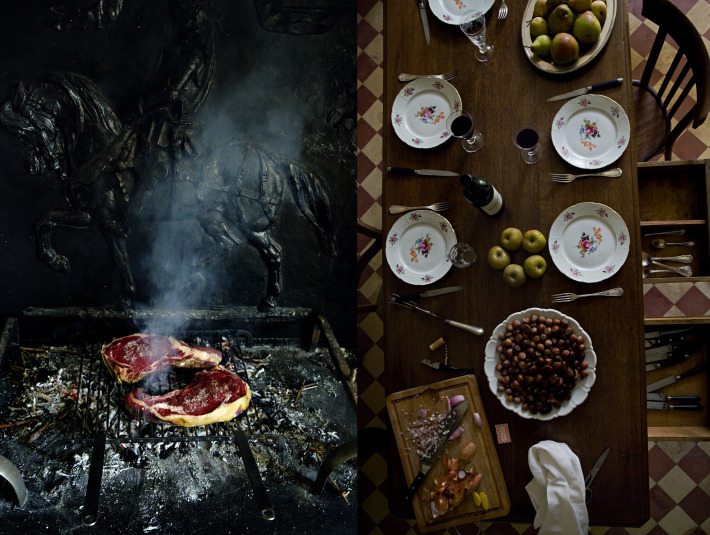
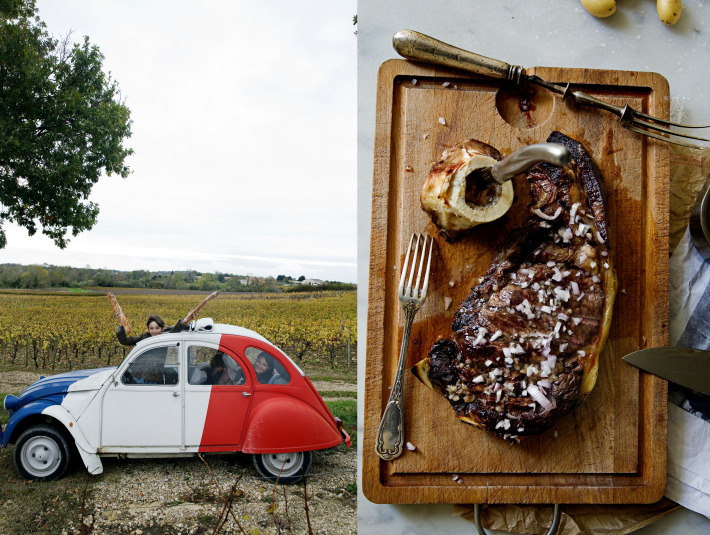
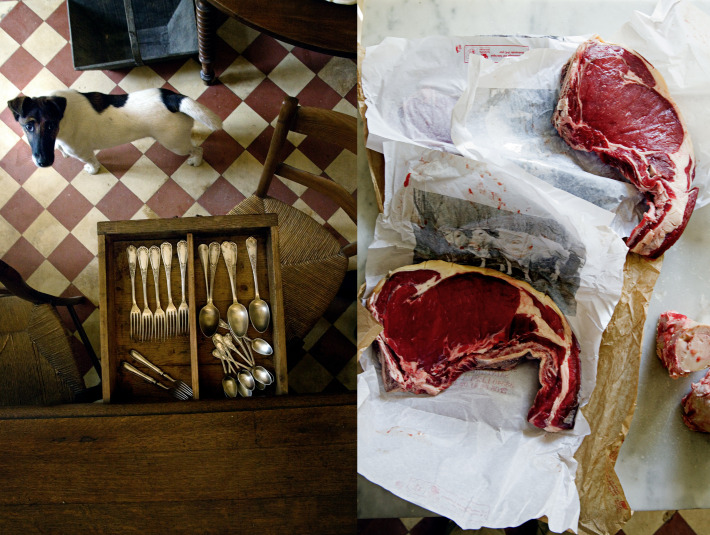
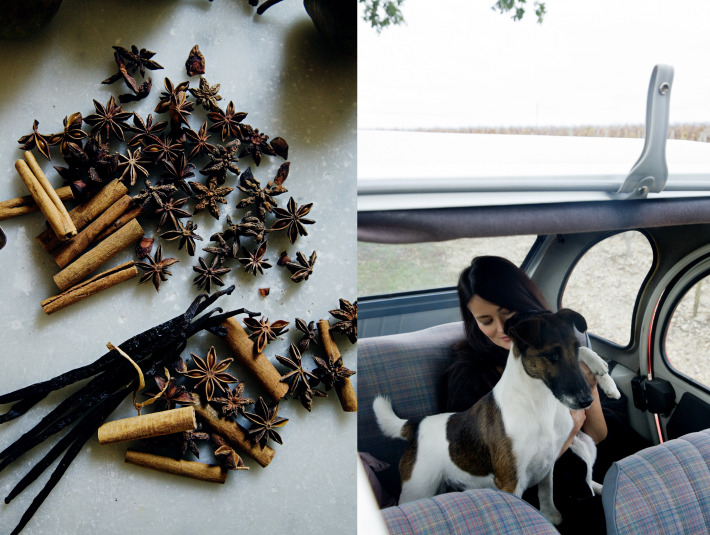
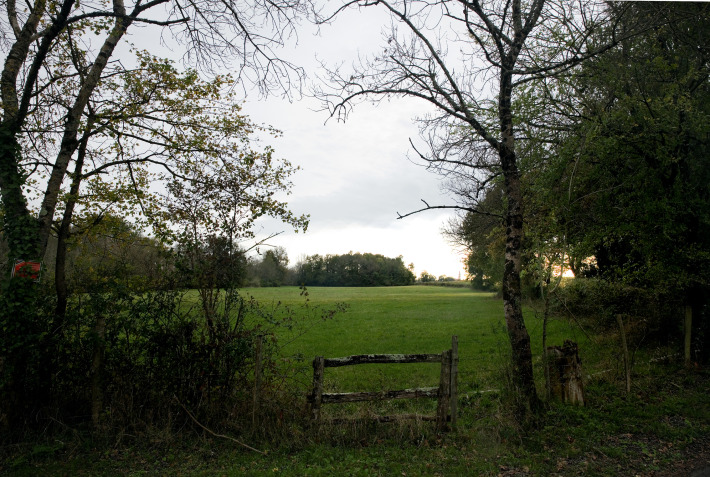
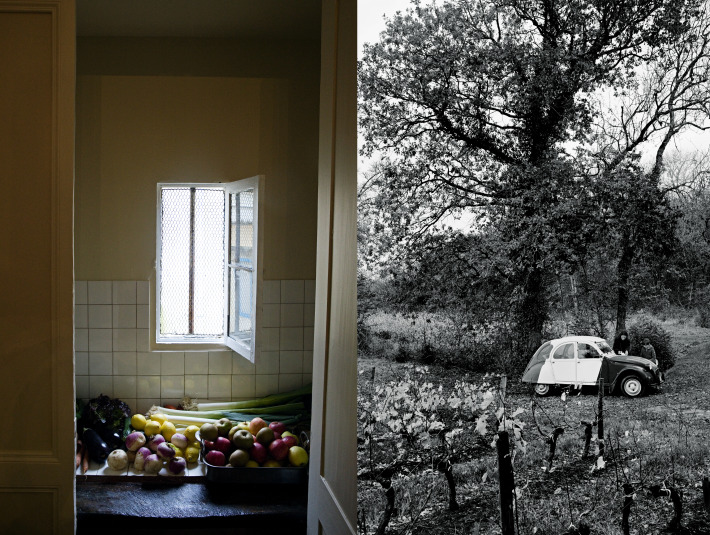
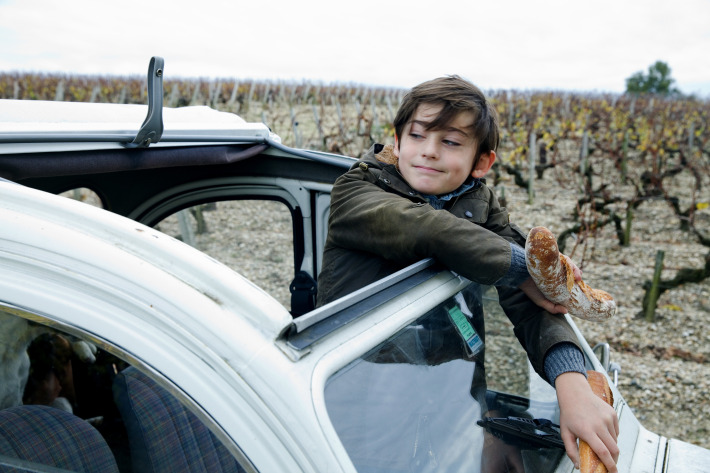
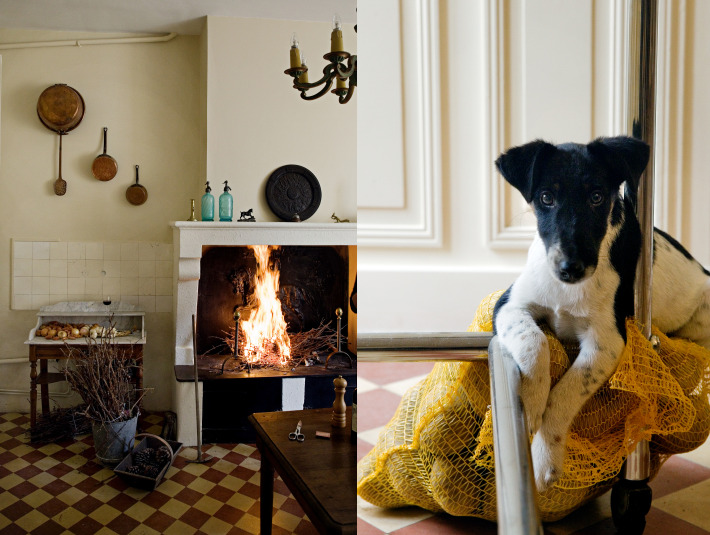
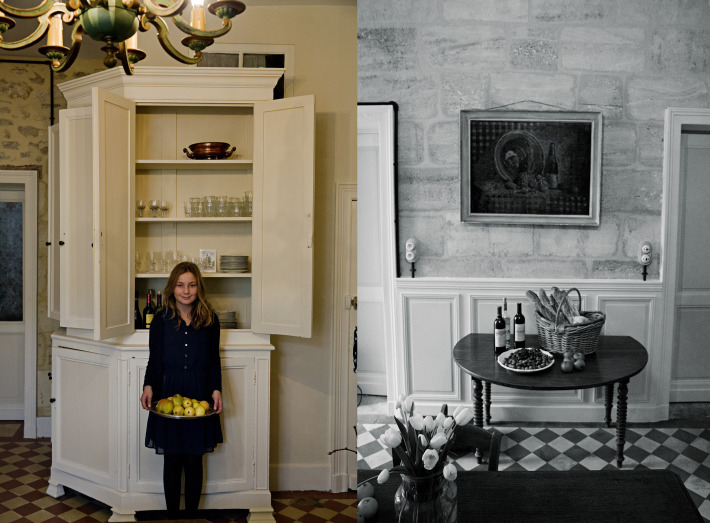
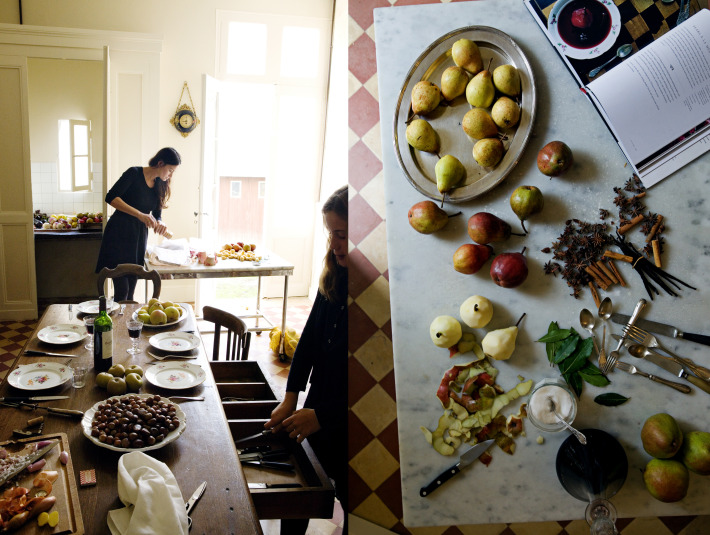
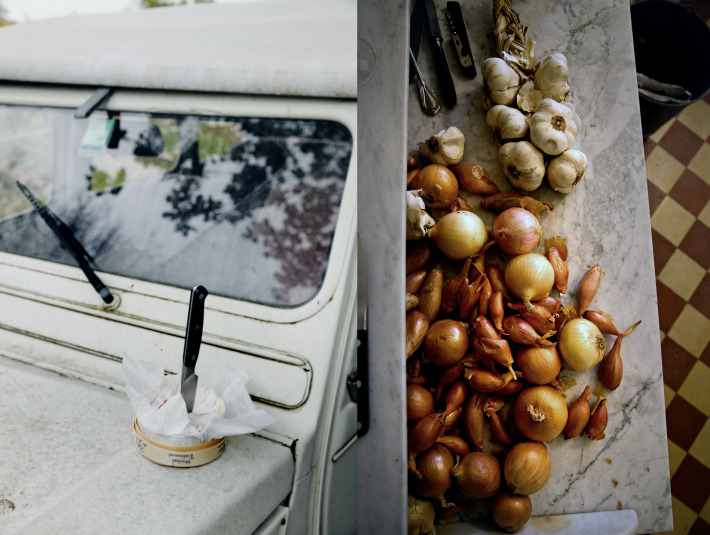
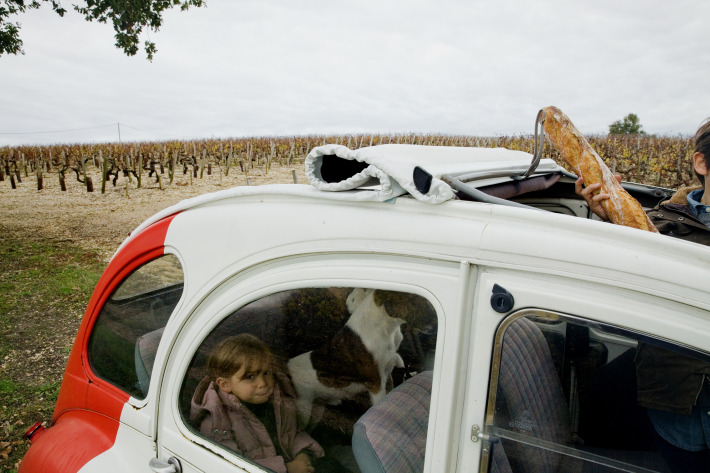
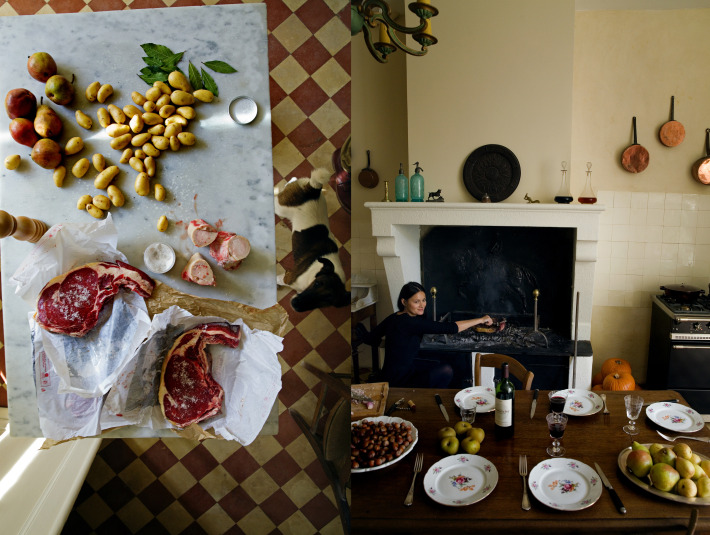

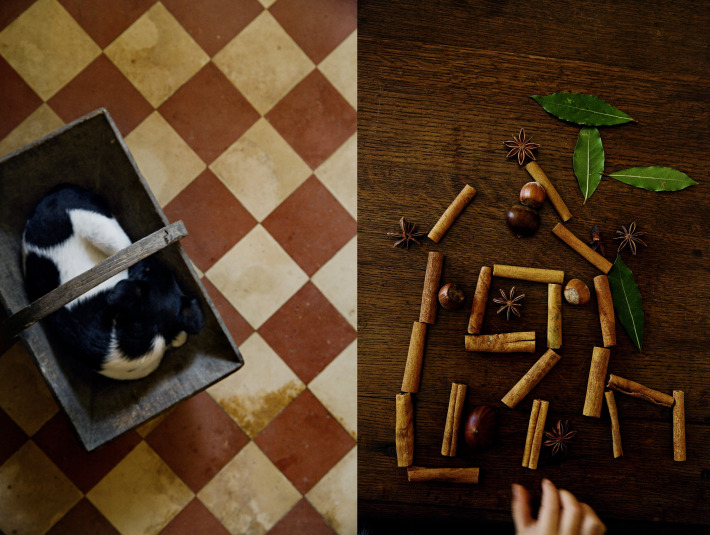
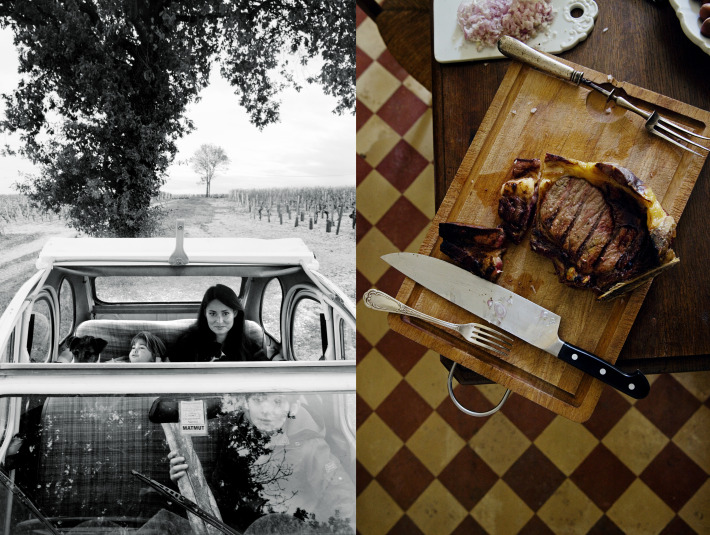
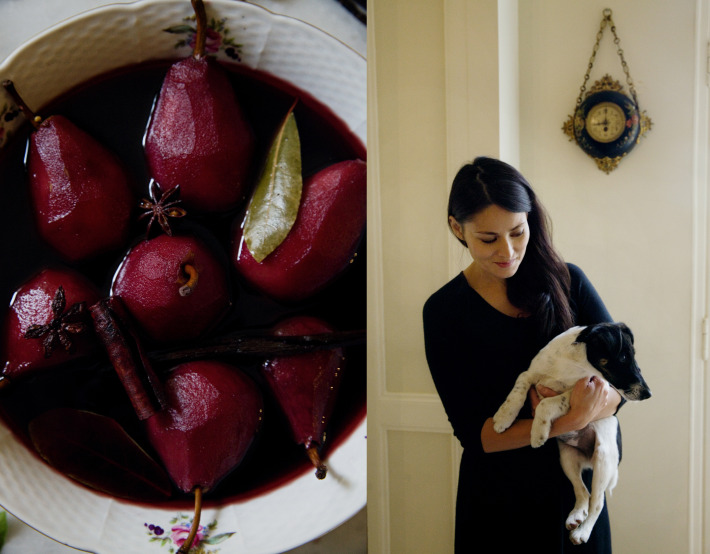
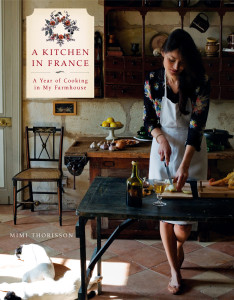
I do agree. About the pears. The painting. And the eating them first. And, of course the utter delight it must be so close to moving in.
Hi Amanda! Pears have such a timeless beautiful quality. 🙂 Can’t wait to move in! Mimi x
How beautifully things fall into place! Indeed you were destined for that house. It’s already rich which a wonderful food history from Plantia Plantieu and now you get to continue making more history in it. I’m so glad your workshops will be starting soon! I’m planning a special trip to Paris, and Clisson in May of next year, and I was hoping your classes would start by then! Otherwise I would have postponed my trip just to make sure I could take a class with you 🙂
Do you have a newsletter sign up for classes yet? I’d love to get more information. It’ll be a dream come true to learn from you!
How did your son’s Médocain Pears with Wine turn out? Is he convinced that the recipes work now? 😉
Bonjour Alyssa! So happy to hear from you, thank you. We will start workshops around the 17th March – I am getting such wonderful response so far! So May sounds good, I will certainly have a few more from March onwards – this is so exciting; We will set up a user-friendly newsletter with sign-up options this month. Hudson’s pears were delicious, he was so proud to make such a grown-up dessert 🙂 Mimi X
Aaargh….what a lovely and truly exciting post! How sweet of Hudson – the recipes definitely work, not that I’ve had a chance to try them all yet, of course, but they work.
Darn it, the 17th is the date that my father arrives back from the West Indies and I have to collect him from the airport and settle him back home otherwise..you know I’d be there. The workshops sound FANTASTIC.
Bravo bravo, Mimi. xx
Thanks my dear Susie. Settling your dad is far more important than coming here! No worries, I will be organizing more, so I will definitely let you know the dates:) See you very soon. Mimi x
Lovely post as usual Mimi. I do have to ask..how does your husband get those overhead shots of the table? He has wings doesn’t he 😉 Hehe…
Hi Elissa, thank you! Oddur is always standing on a chair, or literaly on the table… Whatever he can climb on! Mimi x
Another wonderful post. Thrilled you’ll be starting the classes in the spring–hope to get to france in june and, if so, will see if there’s space in some mid-June classes.
Hi Casey! Thank you so much for your interest! I have noted down all those who would like to join my workshops and will get in touch when I get all the details.Would you mind sending me your email? Merci, Mimix
Your excitement permitted your post.
Only one request, please. can we have a picture of the baby?????
Hello! Thanks! And yes, will share more pics of baby Audrey. Promise! Mimi x
Dear, dear Mimi ! I will be able, and i am joyful about it, to come in march ! Est-il possible de “réserver” ? Je ne sais pas trop ce qu’il faut faire. Merci pour ce blog merveilleux, et pour le livre, que je dévore et que je chéris. NK.
Hello! Oh, I am so happy to hear you would like to join us, thank you! I am gathering everybody’s name and getting things organized. Could you please send me your email? Will send you all the info very soon. Merci! Mimi x
Your new chateau sounds and looks lovely. I can’t wait to visit! Participating in one of your cooking classes and eating at your new restaurant will make the perfect excursion when visiting Paris next summer. The pear recipe is calling me…
Merci Keri for such kind words! I am so excited to finally organize these workshops. I am finalizing a few details and getting back to all interested parties. Would you mind sending me yor email? Merci, Mimix
You just warmed my soul as I sit here in MN among early snow and early cold. The post gave me smiles and sweetness and hunger! And I just ate.
Merci Claudia! Mimi x
Excellent news on the workshops. Do you have dates for April? Would love to reserve two spaces!
Oh David, thank you so much for your interest for the workshops – I am so happy! Could you please send me your email address – I will send all info (dates etc.) this month. Merci, Mimi x
Your beautiful cookbook arrived this week and I am beyond thrilled to start my French cooking journey. The pictures transport me to the very heart of what I can only imagine the French countryside to be, all from my little rainy corner in Vancouver Canada. Merci!
Rhonda, a million thanks for getting my book! So happyto hear you are enjoying it. Wishing you lovely meals. Mimi x
Bonjour Mimi! Beautiful post! I wish I lived close to NY!!! Enjoy your time there and safe travels! I cannot wait to join you at your workshop!!! xo, dana
Thank you so much Dana! Will send all info this month on dates etc. We are so enjoying NY – I am in love with this city. See you soon 🙂 Mimi x
I am a new reader + how wonderful you are + Madame Plantia Plantieu could not be in better hands. xxpeggybraswelldesign.com
Merci chère Peggy! I hope Plantia is happy – I can definitely feel her soul in the house. 🙂 Mimi x
Hello Mimi, I hope this finds you and your family well. I’m so excited for you; it looks like you’re turning your new house into a lovely home! A couple weeks ago, I scoured the bookstore searching for your cookbook to no avail. Just when I was about to give up—there was a stack, ready to be devoured. I will let you know how my first attempts turn out, but the photographs look delicious enough to eat!
You have no idea how much peace it brings to peer into this little window you’ve opened. Sometimes we all need to be reminded of just how beautiful life can be. I’m very interested in attending your first workshops; I’ve never been to France and this seems like the perfect introduction. I want to reserve a spot now and I will contact you further. Thank you for sharing your passion and inspiring others to do the same. Take care.
Bonjour Monica! Thank you for such a sweet comment – I hope you are enjoying my cookbook, and had a few lovely meals from it? 🙂 As I mentioned to others, I am getting all the dates/info organized and will get back this month to confirm. Merci! Mimi x
Just received your beautiful cookbook and have devoured the recipes, photos and commentary. I have already made several dishes. Thank you for your posts–I always look forward to them.
Good luck in NYC!
Thank you Stacey! So happy to hear you enjoyed the recipes. Mimi x
Well Mimi,
if I can’t come to the first class in March, I will certainly see you in NYC next week! How fun! I will bring my book and my red Goyard so you know it’s me!
Stacey
Super Stacey! I will be on the lookout for the red Goyard girl! See you real soon! So excited! Mimi x
your kitchen looks like a dream, with that fireplace! but I am most distracted by the photo of the DOG AND POTATOES!!! congratulations on the book, the workshops, the château, the delightful discoveries of Plantia, it is all like a page out of a storybook.
Thank you Myriam! Yes, this new house is an open book, all there for me to explore. That little dog is called Walnut… how sweet to sit on the bag – it was a perfect random shot! Mimi x
Congratulations on dreams coming true.
Oh my goodness I can’t make the first class but I would love to come to one in October! How lucky we all are to have such a wonderful mentor who not only dearly loves her family but is able to find the time to share her life and cooking with my fellow readers and myself. Your cookbook is “UTTERLY CHARMING and I can’t wait to give it to family and friends at Christmas! Thank you for opening your heart and allowing me to experience a little “slice of heaven” with every one of your posts! Blessings
Thank you Stephanie! You are too kind! See you very soon – will inform you as soon as the dates are finalized! Mimi x
Thank you Angela! This is the beginning of an exciting adventure! We’re all in it together! Mimi x
Hello Mimi…what a wonderful post. I have just found your work and I am truly in love with your cookbook. You have been such an inspiration! My company is very close to your book signings in NYC and I am looking forward to meeting you. Also, I am very interested in attending your Workshops. See you in NYC and congratulations on producing a beautiful piecen of art. Sweet Joy
Thank you so much Joy! I am so happy to hear you will come to the book signing – I am so excited to meet you! Will tell you all about the workshops then! Mimi x
This reads like a magical, enchanted novel that I cannot put down. I love your new home and delight in the adventures it is sure to share. I am enjoying your cookbook, grilled rib-eyes next, my love simply cannot believe we can improve on ours, but I am feeling it is fated.
Thank you for the enduring inspiration,
Stacy
Thank you stacy for such kind words. I am so happy to hear you are enjoying the cookbook! Mimi x
Please put me on your list for the first class March 2015! I may have three girlfriends making the trip too!!!!
Thank you Joan! I am so happy to hear you want to participate! Could you please send me your email? Will send all the info very soon. Merci Mimi x
Darling & delicious. Here’s toasting your book!
Merci Jill! Mimi x
I have so enjoyed your posts over the years, following your journey so far has been inspiring. Yesterday my book arrived and has already been read and pondered over. How exciting you already have a date for starting your cooking classes, something I am looking forward to. Congratulations on producing such a lovely book.
Thank you Bernadette! I am so touched to hear your kind words – I can’t wait to meet you! Wishing you beautiful meals (from the cookbook I hope!) 🙂 Best,Mimix
Dear Mimi,
What a nice post, and lovely stories about your new house! Can’t wait for your bistrot to open…
I have your wonderful book at home, it is amazing to have the impression to Know the author! Your Louise who is my Églantine’s âge is so touching.
Thanks for the recipes, we’ll have côte de bœuf for lunch…
Take care and bravo.
Amitiés Cécile
Bonjour from NYC! Thank you for all your kind words Cécile – you are always filled with such kindness and warmth. Mimix
Wonderful description of St Yzans thank you, much better than my previous attempts to orientate via Google street view.
Uncle Amazon, or in your case ‘the stork’, delivered your baby last week and yes, she IS beautiful.
Friends here in Jervis Bay have a 2CV Citroen. There’s a special faraway feeling ie to France each time I see it puttering/spluttering along.
Sounds as though the renovations and plans with the cooking workshops are falling into place. You’d have made Plantia proud!
Merci chère Jude! Funny, I saw the google maps car a few weeks ago, going back and forth filming the streets, I might even be in one of the shots! So happy you received the book, now all I can wish is that you will enjoy it and most of all enjoy a good meal! Merci, Mimi x
because of you, I finally love fall now !!!
Thanks again for recipes
Merci Nancy! There’s so many beautiful meals to make during this pre-festive season! Mimi x
That’s some fireplace Mimi! Is that a horse and horseman behind the smoke? Is he attached to the …? (they have the unfortunate name of firedogs here).
Very very nice looking Stove also – Brand?
Yes, that’s a chevalier, some musketeer! He is there to guard our fireplace, in all its glory. As fo rthe stove, it is a Lacanche (from Burgundy). I went there a last month to pick 2 stoves (I have 2 kitchens). They are the beating heart of our house! Mimix
Est il possible de réserver via votre blog ? Je voudrais réserver pour deux personnes le dimanche 22 mars ! est ce possible ? merci beaucoup
Hi Nancy! Je vous enverrai un petit mail ce mois-ci avec toutes les infos – pourriez-vous m’envoyer votre adresse mail? Merci beaucoup, Mimi x
Agree, the dog with potatoes is an awesome photo. Such character comes through the dog! Also love the red and cream tiles, so much.
Hi Tunie! Thank you so much! Th elittlepup is called Walnut – she’s so cute and very excited! Mimi x
It’s just unbelievable how your enjoyement reminds me life in our vacation house ! the fire place where my father used to cook, the old citroën, a way of living I loved so much ! I am so impresssed too with your “rendez-vous” with this house and the name of Plantia Plantieu, a real name for a “roman” ! Your story talks to my heart, wakes me up about a life I would be so happy to live again. Thanks so much to share your dream and happyness.
Thanks! Plantia Plantieu is certainly a perfect name… there’s so many stories I just don’t know where to start! Mimi x
Dear Mimi,
Pears à la médocaine is the perfect comfort dessert for today, thanks! It’s so rainy here in Bordeaux…
What is this thing with children and staircases ? When I first visited the little house we bought last year, I saw my (future) children running in the staircases and fell in love with the house …
I am sending you an email regarding the workshop.
Enjoy New York 🙂
Hi Alice! Bonjour from NYC! So happy to hear you want to come for one of my workshops – will get back to you asap with more details 🙂 And yes, no wonder staircases are so meaningfull. They are a sign for our deeper self, a symbol of achievement, development and moving up in the world. That’s why we all want kids running in staircases! 🙂 Mimi x
Un grand merci et félicitations pour ces magnifiques articles !! Je suis votre blog depuis cet été et nous rêvons devant vos recettes et photos qui mettent si bien en valeur la cuisine et le terroir français. J’attends avec impatience la publication de votre livre en français, car j’ai du mal à cuisiner autrement que dans ma langue maternelle 😉 Bonne continuation dans tous vos projets !! Bien amicalement, Alice Rogéré.
Bonjour Alice! Merci pour votre gentillesse – mon livre sortira cet Octobre en France (Hachette). Mimi x
Bravo Mimi pour être allée jusqu’au bout de vos rêves, on ressent véritablement dans cet article votre amour pour la cuisine et toute votre sincérité et excitation pour ce projet de maison d’hôte. Lorsque je serai de passage à Bordeaux, je sais ce qu’il me reste à faire !
PS : j’ai adoré la partie sur les préoccupations de votre fils, qu’il soit rassuré, j’ai essayé l’une de vos recettes et je ne suis pas en colère, bien au contraire 🙂
Bonjour! Nous sommes si heureux de partager nos passions, et surtout ce livre de recettes… fait avec amour!
Merci! Mimix
votre blog est délicieux, bravo!
Merci! Mimi x
Mimi, it is has been too long since I’ve been here to comment, but I just want to tell you that your personal and professional successes are such an inspiration! Your husband captures such lovely moments in your lives, your children are gorgeous, your dogs are simply hilarious (I love how this little guy has his potatoes ready for a photo shoot!!!) and your kitchen is marvelous. My French style kitchen is similar; it is SIMPLE but has that distinct French design and I love it.
Many more happy moments to you, Mimi! Anita
Thank you so much Anita for your kind word.! We are thrilled to be able to share our passion with you! We are working hard to make the house alive, and the kitchen was our number 1 priority. I hope you will enjoy the book, Mimi x
Hello Mimi, are you sure you were not an architect in some past dream? Your description of your new home immediately places me into the poetic space, where I roam in search of the splendid, blended scent of vanilla, star of anise and cinnamon. Your new home, that desperately awaits for you to remain, permeates the sceen with a wonderful cooking aroma – how I wish for a moment, I could be on Mimi’s restoration team at lunch time. How fantastic that you have a starting date, I too will dream and perhaps…
Oh, and please do tell Hudson not to worry, his mama’s recipes work deliciously. All the best in New York!!
P.S. You look so radiantly happy, and rightly so. Cheers!!
Merci Gee Gee! We just got back from NYC, that’s why I have been responding so late. Well, not sure about the architect part, but the house does inspire a lot of story-telling… I do hope to meet you there one day! Mimix
YES!
… pure magic is happening here.
***************
Since i received your cooking book it´s still presented on our big old oak table. It´s becomig the good spirit of our dining room:) In both senses-
And this burgundy red…. ♥♥♥.
# i still have a princess dream since i got your news of buying this house# to celebrate my wedding in the Thorisson Villa, with your food, endless wine & only best friends.
Have a great day, Aileen
Hi Aileen,
So happy you are enjoying the cookbook, I am thrilled to know it has a place on your big old oak table. merci! As for your dream… well, who knows, right? Not sure if I am equipped to cater to a wedding party… But it all sounds wonderful! And congrats! Mimi x
Dear Mimi,
I applaude your way of living life away from the hustle and bustle of a big city and give your kids a childhood in the French countryside. It’s not easy to take the decision to move away.
Now here’s a question for you, how do you manage to cook for everyone and balance your tours and workload? It’s always interesting to hear real stories of how women balance being there with wholesome food and hugs and care for their family but also being successful and find time to build something for themselves!..while looking calm and collected nevertheless!
Good luck with the restaurant, we’ll definitely come to visit when it’s up & running! Kiki xx
Hi Kiki, It’s an interesting question because it’s not something I think about often. I guess the trick is not to take on more than I can handle and not put too much pressure on myself. Priorities are also important and in this house family always comes first. I would love to publish more on the blog and answer comments more promptly but if that has to wait then so be it. The same goes for magazine work and other things, sometimes deadlines are stretched. My way of thinking is that this has to be fun so that I and all of you can enjoy it, so even when it’s “work” it’s not really work, after all I am doing what I always wanted 🙂 Mimi x
photos are wonderful! will see you in New York!
Thank you Marianne! I had such a wondeful time in NYC! Mimix
Lovely pictures, beautiful book, I’m buing today for my sister’s birthday!
Thank you so much Patricia! Mimi x
Bonjour Mimi,
l’inspiration que vous donnez continue.Hier j’ai reçu votre livre.Tout le temps je le regarde, meme chaque ingrédient des recettes pour les préparer un jour.Et aujourd’hui je vois un beau nouveau article dans votre blog, et avec ça on a l’impression que le livre a une vie que continue.Merci beaucoup et a bientôt,Isoldina
Merci Isoldina! Je suis is heureuse que vous aimez le livre, et que le blog lui offre une seconde vie! J’espère que les recettes vous plairont! a bientôt, Mimix
Dear Mimi,
I am so in love with your new house, every thing sounds and looks beautiful, the tiles, the pieces of furniture, the marble tops, etc… Oh in Love!
Good luck in the restoration, May God bless you, your family and your new home.
PS I am traveling back to London this Monday, I can’t wait to hold your book and look in the pages, I am sure I will hug it.
Best wishes and much Love xx
Greetings from London, enjoying my kids and the beautiful London at this time of the year.
Dearest Mimi,
I can’t believe it I have your book now with me, so in Love with it. It is like meeting you again and your lovely family. Gorgeous photography, delcious home cooking recipes, beautiful. I wish it was a signed copy.
Thank you Mimi.
Best wishes xx
Hi Rowaida! Thank you so much for your heartfelt message! We just got back from NYC – I didn’t really have a chance to open my laptop and answer the comments. I am SO happy to hear you are enjoying the book. I will be coming soon to London in the spring so hopefully we can meet then? Regards to the family. Mimi x
I did a pre order through Amazon, it will however only be arriving in December, I can’t wait for it.
Kind regards
Vicky
Thank you Vicky! I hope you will get it sooner. My mother-in-law ordered a few and got them earlier than expected). Merci! Mimix
Dear Mimi, i would love to partecipate to your first cooking workshop and to have informations about it. 🙂
Hello! Thank you so much for your interest. I will be setting up a newsletter with all the practical details so stay tuned! Please do send me your email address here or on mfthorisson@gmail.com. Merci! Mimix
Hello Mimi, I hope this finds you and your family well. I’m so excited for you; it looks like you’re turning your new house into a lovely home! A couple weeks ago, I scoured the bookstore searching for your cookbook to no avail. Just when I was about to give up—there was a stack, ready to be devoured. I will let you know how my first attempts turn out, but the photographs look delicious enough to eat!
You have no idea how much peace it brings to peer into this little window you’ve opened. Sometimes we all need to be reminded of just how beautiful life can be. I’m very interested in attending your first workshops; I’ve never been to France and this seems like the perfect introduction. I want to reserve a spot now and I will contact you further. Thank you for sharing your passion and inspiring others to do the same. Take care.
Hello Monica! Thank you so much for your sweet words. We are preparing a newsletter with all the practical info asap so stay tuned! If you could send me a mail on mfthorisson@gmail.com with your email address that would be great! Thank you! Mimi x
Hello Mimi,
Please do send me information regarding the cooking class in March 2015, we are very interested in attending- especially interested in visiting this charming town you found and seeing the renovations on that amazing house!
Thank you so much Lisa! I am delighted to know you want to partcipate in u-our future workshops – we’re getting al lthe logistics in action and sending out a newsletter asap. Could you send me your email address? Merci! Mimi x
This is gorgeous and I cannot wait to buy this cookbook! Felicitations on the belle maison!
Thank you Wendy! Mimix
Chere Mimi, congratulations on your new beautiful house and book! I simply cannot wait to visit you, take some cooking classes, meet your children and dogs… I have received your book few days ago and my family and I have enjoyed cooking from it every night…Please assure Hudson that the recipes indeed work out amazingly well and they make us all so happy! My six year old Eva loves making the Clafoutis and can’t wait to try Madeleines, her favorite:)
All my Best and bonne chance for your upcoming trip to New York!
Oh, thank you so much Lana! We just got back from NYC and our trip was great! I got to meet so many wonderful people at the book-signing events – loved it! I am very touched to hear your kids are cooking my recipes. How cute! Merci, Mimix
Hi Mimi. You are certainly very brave to take on such a project, and it’s looking wonderful already! The photo of the beef is making me very hungry. That’s how my hubby likes to cook it, over vines. It’s one of his specialties, served with grilled red peppers, of course! Have a great time in New York. x
BTW, will you be coming to London for a book signing? I’m sure my daughter would love to meet in person the creator of her (and her brothers’) favourite dessert – your apple and prune croustade! You are very popular in our household! X
That’s Zelda, not Sleds!
Thank you! I will be coming to London for a book-signing in the spring, so let’s stay in touch! So excited about that. Mimi x
How lovely to see your beautiful eldest daughter in the photos!
Thank you! Mia is such a sweetie – sometimes she is camera-shy, and sometimes not! And I respect that 🙂 Love it when she want sto participate. Mimix
Je suis vraiment intéressé pour les cours de cuisine et j’aimerais être là en mars, comment on fait pour s’inscrire?
La 2cv m’amène beaucoup des souvenirs, quand on était petits, mes frères et moi, ma mère avait la même voiture! Je l’aimé tant que quand il l’on vendu j’ai pleuré !
J’hâte de participer à un atelier !
Bon voyage à New York !
Merci Eva! Nous rentrons tout just de NYC – quel voyage fabuleux! Nous préparons actuellement une newsletter pour les personnes interessées de participer aux ateliers – envoyez-moi votre email SVP mfthorisson@gmail.com.Merci! Mimi x
I would be very interested in your first cookery classes so please let me know if there is any chance I could join you in March.
Secondly I did pre order your cookbook from Amazon and I did send an email with my order number but I never received my free photo. Am I just unlucky or have you not sent them out yet? Loving your blog as always. x
Hi Jill! Thanks so much for ordering the cookbook – I hope you will enjoy it. As for the prints, I’ve had lots of questions regarding this…they come separately and are on thier way! So you were not unlucky 🙂 Thanks so much for your patience. Mimix
Upon your book’s arrival in my mail I was instantly engrossed into a world of warmth and endless beauty. Mr. Thorisson’s photography blurs the line between light and canvas. Each recipe feels like cultivating a composition with ease and it sits atop my desk in plain sight inspiring me at every angle. I am deeply enjoying your book. It allows me to slow down and create and my husband is greatly enthusiastic by the fruits of my delving between its pages. This book, your family, your new home, workshops, and cafe are all extensions of a seed of your beautiful dream which as grown into a blossoming tree encouraging us all to chase our greatest passions for which we find meaning and quench the thirst of our hearts. I know that I’m rambling pretty prose but I can’t help but express myself in this way as your blog and your book have made a difference in the way I see things. My soul is connected to the food I prepare and its sensibilities are linked in the memories I create with my friends and family with each dish. So on behalf of my friends and family to yours, Many Congratulations and Thank you! Your new home is so beautiful! Like a castle! I am a sucker for old stone, antiques and of course timeless recipes 🙂 You live in a painting! Enjoy every bit of it ^_^
Thank you for your inspiring words! I love how you say, we ‘live in a painting’! Well, we try our best but our surrounding certainly feels like that! Hopefully you will visit someday. It was so symbolic to plant a few trees, especially the magnolia tree in the center of our entrance courtyard. May it blossom and grow! Just like our family! Cheers, Mimix
That’s got to be so exciting to continue the legacy of a former cook in your new kitchen! Wishing you many healthy and bountiful meals. How adorable that your son is concerned about the recipes in your book…I am not the most patient in the kitchen so I will have try one out and let him know. Enjoy your new nest.
Thank you! It does feel like I am ‘on top of my kitchen’ when I am cooking from the cookbook! I hope you will enjoy the recipes and make Hudson feel relieved 🙂 Mimi x
Hello Mimi! I would love more information on the March workshop! Would love to catch to train to Médoc!
Bisous x
Bonjour Katherine! Iwill be sending a newsletter soon so stay tuned! Would you mind sending me your email? Merci, Mimi x
Oh my yummy yummy yummy. I need to get back to France, like yesterday 😀
Bonjour Chanel! It’s yummy indeed! 🙂 Mimi x
I have just stumbled across your blog. It is absolutely gorgeous. I’m going to tell my mother because I know she’s love it too, particularly since she is planning on a trip to France (from Australia) next year!
Hello Amber,
So happy you discovered us in our little corner of Médoc, hopefully your mother will visit this part too! I hope you will enjoy our recipes. Mimi x
Bonjour Dear Mimi,
Are you happy with your new stove?? Is it taking a little tweaking to get just right??Oh Mimi, I know that sadness of leaving your new home to go back to the old…..not long now.
The stove in Jindivick, being wood-fired, has taken a little getting use to but I just love it now. Firstly, it roasts meats beautiful, secondly, it warms the kitchen. I’ve become Felicity Kendall from The Good Life also reading, knitting and warming my toes by it. It’s a Stanley, and came from Waterford in Ireland, a 6 month wait so I could have it in red. I believe red appliances work better…ha ha.
Last night, I roasted a chicken bought from the farmers market. The breeder also sold the birds. If it wasn’t for his thick Aussie twang, he could have passed for a Frenchman. His passion explaining how long to cook the bird, what temperature is best, the breed and nearly its blood group!!!!………it’s the best I’ve eaten since France and the best since I was a little girl, chickens, raised by my Father. Oh yes Mimi, the recipe…….Roast Chicken with Creme Fraiche and Herbs…….you may be familiar with it.
Bisous
xxAnita
Bonjour Anita,
So happy to hear from you! Oh I love my new stove! I am actually waiting for a double stove (in black) and a red one (yes, Burgundy red) from Lacanche to arrive soon (we are one big family so a double stove is very necessary!). Lacanche was kind enough to lend me the black one as I need to cook immediately. I am in love with them – they are the heart of our house, the family and of my cooking bien sûr! It adds a special place in my heart to know the family behind these appliances in Burgundy – so it makes my stoves and cooking extra-special. So glad you met a wonderful chicken man – it changes chicken cooking forever, no. Mimi x ps: just got back from NYC last night – it was truly an amazing trip. 🙂
Thank You Thank You Thank You Dear Mimi for allowing me to share your magical journey with you! Your blog is simply wonderful and your cookbook magnificent! I would love to reserve a spot for Fall 2015 so let me know when you finalize everything! I hope the upcoming Holidays are filled with endless love and blessings for all!
You are so welcome Stephanie! I am so thrilled and touched to get so much enthusiasm for my workshops – we’re getting sall the ‘logistics’ ready and will send all the info soon. Do send me your email on mfthorisson@gmail.com – merci! Mimix
Mimi, I would love to take your cooking class on 17 March. Can’t wait to find out the details — but count me in. Susan
Oh thank you Susan! We will do our very best to send out a newsletter asap so you can get all the info. Could you send me your email address on mfthorisson@gmail.com. Merci, Mimix
Those pears, they look like Heaven’s food, really!
http://justsem.wordpress.com/
Oh merci! I hope you will try the recipe! Mimix
I was just talking about HUDSON at lunch yesterday with my husband….GIAMPIERO!You see I have started to read your book and the page was open.I explained Hudson was our third SON!!!When you want to let him go which I know will be NEVER!I adore the story of his wanting to make a recipe!ADORE……..then MISS LOUISE and HER COUNT is ADORABLE!!!The stories of the HOUSE are magnificent!I would be just like you MIMI asking all the older people their memories…….FATE.You were meant to find this home!!!XOXOXO
Oh dear Contessa, we are certainly on the same wavelength. We are all looking forward to meet you someday, and will try my best to work on an west coast trip for 2015. Maybe I’ll be there sooner than you think! We just got back home last night from NYC – what a fantastic trip, my favorite part was meeting all the fabulous people at the book-signing events! Bisous, Mimix
[…] am just so in love with Mimi’s writing. I want to live your life […]
Coincidence, fate, or merely serendipity, you were meant to bring that beautiful home back to life. Thoroughly enjoyed this post and hearing more about Plantia Plantieu. Have no doubt that room-by-room that house will take on a beautiful new life for you and your family. I hope to stop in next week when you are in NYC for book signings. I expect you will have many happy fans awaiting your visit.
Bonjour Rayna! I do hope we met (unfortunately I did not catch all the names). The book-signing events were the highlights of my trip – I adored meeting everyone, some even brought me presents, some brought their dogs (I even got to hold them!)… Unforgettable memories forever! Mimi x
I love coming here! I always learn so many new things, about food, about France and about firewood. And that’s just this post. 🙂
Your bone marrow trick is intriguing and I think I may have to try that and see what we think.
Congratulations on all your hard work and thank you for creating this online place. It is magical.
Thanks Heather! It’s a pleasure to share our lives here in Médoc – hopefully we can add a little magic touch on everyone’s tables through my recipes! A meal is always more interesting with a story behind it, right? 🙂 Here in the Médoc, we love spreading a bit of goodness on grilled meat. Bone marrow works wonder, but my good friend Fabien sometimes adds butter to his grilled meat… why not? 🙂 I hope you will enjoy this variation! Mimi x
It’s so wonderful that you’re in New York! I’ll definitely come to the signing event, I love your blog so much, it will be wonderful to meet you!
So excited that everything in my comment is “wonderful” hahah
Thank you Katie! I loved meeting eveyone at the book signing – best time ever! Thank you. Mimi x
I would like to know more information concerning your March classes and also future classes.
Merci
Thanks, I just received your email. Will update you soon. Thank you so much, Mimix
Love, love, your post! Wish I could come to your first class or any! Maybe one day! Love U
Oh yes, I hope so! Thanks so much and see you soon, Mimi x
Sounds absolutely fabulous – I am very interested in your first cooking class in March. Please when you have details of price etc please forward. I will be comkng from Cape Town South Africa – Many thanks Glynis McLellan
Thanks so much Glynis, I will keep you posted with all the details – I will be making several so no worries on dates! Would you please send me your email address on mfthorisson@gmail.com? Kind regards, Mimi x
Hi Mimi, I was so excited when I received your book! It is so lovely. The photographs are beautiful & I’ve already tried a few receipe… delicious!! Congratulations on the new house, it seems wonderful. I hope I get the chance to see it on day! Best of luck with your future plans. xx camille (from Agen 😉 )
Merci Camille,I am so happy you received the book. So touched by your kind words. Best, Mimi x
Hi Mimi, I would love to sign myself and my husband up for this workshop in March, how do we book please?
Hi Tanya, thank you so much for your interest! Please send me an email to mfthorisson@gmail.com and I will include you in the upcoming newsletter! Merci beaucoup, Mimi x
Bonjour Mimi,
I’m a long time follower but first time commenter. I am interested in your workshop for the 17th of March 2015. Please keep me updated about details once they come to light.
Well wishes from Champagne Ardenne.
Merci Shannon. I am delighted to hear from you! Please send me your email address to mfthorisson@gmail.com and will will get back to you soon with amm the details. Best, Mimi x
Your blog is just the most inspiring ever!!! And the recipes!!! Amazing! I will be there to purchase a second book for you to sign in NYC!!! Can’t wait! Safe travels!
Thank you Olga! I had such a wonderful time in NYC, and the best time I had were at the book signings! (we just got back last night!). All the best, Mimi x
Beyond fabulous Mimi! Would you like to adopt me? I’m very well behaved.
If not, is there some beautiful unloved house, with a few hectares, that needs a new family to bring it back to life in your region?
Fab book!
Enjoy NY!
Oh la la! Well, there are a few houses left that need a bit of life! 🙂 You’ll have to come & visit! Mimi x
Bonjour Mimi. I received your book last week and it it brilliant. I am showing it to everyone (but no one can borrow it yet). My husband says that many of the dishes he has looked at remind of him of things that I make. However, he wants you to know that he is hoping that your recipes will inspire me to do something that he heartily enourages…use more butter! Your blog is inspiring, the photos lovely. Thank you for sharing. tkp
Bonsoir! Oh it makes me so happy to hear you are enjoying the book! And yes, why not, use more butter, after all, it is the secret on why French food tastes soooooo good! Enjoy! Mimi x ps: and a warm hello to your husband! 🙂
Such a beautiful tale of your new home! I cannot wait to meet you at the signing at Strand here in New York. In the meantime it looks like you have been eating wonderfully at some of my favorite restaurants:)xx
Hi Mimi,
You are such an inspiration. Love the idea of you having your own place, what could be better than surrounded by vineyards.
Your Mother was wonderful at making creeps in your little kitchen in Happy Valley. Her lentil soup was to die for as well.
I hope I can find your book in the shops in the UK?
Would love to come and visit next summer and take some classes.
Love Margot
Merci Alison – it was a treat to meet everyone! Lots of love, Mimi x
Dear Mimi,
I’m from Hautefort, Dordogne and I live in New York city now. I would love to meet with you while you are here! I admire your talent and I’ll try to stop by your book signing at club Monaco.
Lucie
Hi Lucie! It was a pleasure meeting you! We’re back now in Médoc – I am feeling so happy about all the amazing times spent in NYC! A bientôt, Mimi x
Mimi, Your blog makes my heart ache to return to France. I miss it so. I adore everything you post. How do you manage to be so chic and do so many wonderful things with children and a new baby!
Hi Indi! Thank you! I hope you will be visiting France soon. I don’t know about being chic… I guess my mother always inspired me to dress well and feel chic, no matter where I am! 🙂 Mimi x
Hi Mimi,
What a great idea. Love to visit and take some lessons next summer.
All you hard work is coming together.
I will try to find your book in the UK.
Hi Margot – so lovely to hear from you! I would love to see you here in Médoc. Lots of love, Mimi x
Hello Mimi, so amazing! I´m going to fly with my friend to New York tomorrow. We are from Finland and I was planning to buy your book in this trip, before I even know that you are in NYC too. So exciting. We are coming to Club Monaco on Thursday. See you soon.
Love and hugs Sini
Hey Sini! It was a pleasure meeting you – isn’t it funny to be in NYC the same week! Hope you are enjoying the book! All best and hope you are having a great time! Mimi x
Taking a cooking class with you is on my bucket list! Please include me in your mailing list for classes next year. J’adore tout!
Hi Dianne! Will do – please do send me your email to mfthorisson@gmail.com. Merci.
Best,Mimi x
Hi Mimi,
Did you know you are developing quite a fan club right here in Bordeaux! But we haven’t been able to find your book in Bordeaux, not even at Mollat. Are we missing something?
Best wishes, and hope to meet you soon.
Hi Linda! So happy to hear from you! The book will be out in French in October, and Mollat only carries translated French cookbooks, so that is the reason why. I haven’t checked but there must be an english/american library in Bordeaux, no? If not, we need one! By the way, I will be cooking at the ‘So Good’ gastronomy fête in Bordeaux this Sunday 30 November at 11:00 am (on the quai opposite Place de la Bourse) – perhaps I will be seeing you there? All the best, Mimi x
Mimi, you done me dream of this post, congratulations!!!. Muakes from Seville (Spain)!!.
http://openingwindowsculture.blogspot.com.es/
Oh gracias! I hope you will enjoy the book! Best,Mimi x
Your family is just too beautiful, Mimi! And your son is a sweetheart~so awesome that he’s so passionate about your work. 😀 Ps: pears truly are beautiful to paint or capture! Funny how some foods look like art to us foodies.
Oh merci for your kind words Ellie! All the kids are passionate about what we do, in their own little different ways! I remember spending my saturday mornings at art class when I was small, and I would spend hours painting pears. 🙂 Best, Mimi x
Dear Mimi,
your cookbook is amazing..I would love to join your workshop. Please send your infos soon 🙂
regards from Italy
Thank you Bettina – please send me your email to mfthorisson@gmail.com so I can send you all the details in our upcoming newsletter. Merci, Mimi x
A beautiful post. x
Merci Allison! Mimi x
Bonjour Mimi, I was waiting impatiently for the launching of your classes. I would love to attend the first one if there is availability. You can count me in!
I’m trying to resist buying your cookbook in english right away just because it will be easier in french with the measurements conversions but I’m not sure I’ll be able to wait until Jan 2015! Hope to hear from you and thank you for your delightful blog.
Hi Chantal! Thank you for such a sweet message. We are so excited to inaugurate the workshops, please do send me your email address so I can send all the details/newsletter soon to mfthorisson@gmail.com The French translation version of ‘A Kitchen in France’ will come out this October 2015, but just for your info the actual cookbook has measurements in US and Metric (g and liters etc.)… A bientôt, Mimi x
Fall is so beautiful there.
Love the colours.
I was wondering if you had posted a list of your workshops that will be starting?
I think I missed that one.
lovely. cheers
Hi Ingrid – we are working on all the practical details, but we aim to start the first one on March 17th. Please do send me your email address to mfthorisson@gmail.com so I can include you to our newsletter! Merci beaucoup, Mimi x
I can’t be the only one dying to see a picture of the staircase, can I??
Hi Jess! Ok, promise we will take more pics of the staircase! Mimi x
Hi Mimi,
Your book arrived a few days ago. I have never read a cook book with so much delight! I enjoy your stories and enjoy the way you tell them. I also grew up in HK and have relocated to a rural small town in Canada now. We took that step and have not looked back. Love our country life!
Back to your book… my 11-yr old daughter took it to read and all I could hear was giggles interspersed with oooohs and aaaaaahs. She loves food and loves to eat. Your images are irresistible… I’m sharing your recipes with my husband who is our family chef, too, but I will try your recipes myself some time. I took professional French cookery in hotel management school years ago but it was school and my approach then was somewhat clinical. Your blog and book are a great inspiration and I would like to attempt again.
I ordered an extra copy of your book for my friend. Might get more…
Oddur’s photography is stunning and fantastic. You two (and your kids and your dogs…) make a great team 🙂
Best wishes,
Michelle
Thank you dear Michelle – I am so happy to hear you are enjoying the book, especially your little one! Merci! Always makes me smile to meet an ex-Hong-Konger! Mimi x
I’m so excited to have the book— it was such a great package to get in the mail — and its lovely recipes (especially the Roquefort & Walnut Gougères)!
I’m sad to say that I traveled to Kisan for the book signing, and when the store employees found out I had my preordered book for signing, they turned me away.
In order to ‘qualify’ for the event, I was told I had to buy a book on-site. I was rather deflated, having made the trip, since the information wasn’t on this blog, and I can’t make it to the other signings.
C’est dommage, mais bon j’ai quand-même le livre pour Thanksgiving!
Best wishes,
xoxo coco
Hi Coco, I am glad you enjoy the book, that is the most important thing, much more important than having it signed by me. Everything to do with my NY trip happened so fast and when I announced the signing I wasn’t aware of this requirement. I do, however, sympathize with the owners of Kisan, they hosted a great event with food & drinks and felt that only books purchased on the spot should be signed. But since this happened during opening hours and anyone could come into the store you should have simply snuck by and I would have secretly signed your copy – next time 🙂 Mimi x
Hi Mimi,
I came to have your book signed yesterday in SOHO. (I have preoreded it online so I brought the book with me). As I was standing in line I was told by the store employee that I cannot have the book signed because I did not buy it there! What a disappointment…
Hi Regie, Sorry you came for nothing, the day after we had another book signing at the Strand bookstore and they let me sign previously bought copies. If I ever run into you I promise to sign your book, promise. Mimi x
Dear Mimi, I received your Book the other day, I ordered two one for me and one for the friend who introduced me to your Blog . Im so in Love with it, Bravo. Im an American living in France now for 25yrs, in the outskirts of Paris in a quaint little village and love it and have had so much love and passion for French things, myself a cook and baker I can appreciate so much the Love and passion that is felt in all of your posts you have done such a lovely job, you are an inspiration, and so is your husband with his amazing photography, I love how you have embraced Le Medoc an amazing region indeed, they must be so proud to have you almost them, I hope to come out one of these days and cook with you, Bravo to the whole Beautiful Family et Vive la France…a bien tot
Love and kisses
Andrea
Bonsoir Andrea, I am so touched by your kind words, thank you! We have certainly fallen in love with this region, and feel like we are finally becoming local Médocains! 🙂 I do hope to meet you someday! So happy to hear you like the book! Mimi x
Thank you for sharing your beautiful recipes and photos with us! I ADORE your cookbook!
I hope you and your readers will visit my blog! It’s mostly food and fashion, and a couple tidbits from daily life! A bientot!
http://www.redwineandlipstick.wordpress.com
Will check it out Andrea, thank you for sharing! Mimi x
mimi,
such a pleasure reading your thoughts and feelings on your new home. sounds as though you have the beginnings of a suspense novel brewing in your noggin.
🙂
H Layla, it certainly feels that way. We cant wait to get the works and renovations done! Best, Mimi x
You have a beautiful home, lovely family, excellent culinary taste and what appears to be happy dogs. I’m curious as to the breed of these very handsome puppies.
Merci Philip! The pups are smooth fow terriers – we love them to bits! Mimix
Dear Mimi,
I’d love to receive more details about your cooking class starting in March. Would you please send me further information?
Thank you
Tabea
Merci! Please send me your address to mfthorisson@gmail.com so I can send you the nesletter soon. Thank you! Mimi x
I’m always delighted to read you and just as excited with your family project that I already know to be a success. I’m very very happy and crossing my fingers to be able to go to one of your WS next summer holidays 🙂
Thank you dear Maria! I hope to see you soon! All best, Mimi x
Mimi,
It was so wonderful meeting you at your book signing at The Strand in NYC. I would love to come to the March 17 class if possible. My birthday is also in March, what a wonderful birthday gift it would be to cook with you!
Thank you dear Megan – it was wonderful meeting you too! Do send me your email address to mfthorisson@gmail.com or directly on this comment thread – I will send you a newxletter soon! All best, Mimix
[…] Mimi Thorisson’s Kitchen in France […]
I left a comment previously but it didn’t seem to go through. Just want to say my daughter (11) and I are both enjoying your book a lot, and it’s great you included the recipes of some of our favourite Chinese dishes! We like reading about your stories and like the way you tell them. Also, your husbands photography is fantastic! The two of you (and your kids… and your dogs…) make a great team!
Thank you so much Michelle! I hope you will enjoy the recipes! All best, Mimi x
[…] Grilled entrecôte à la Bordelaise […]
Dear Mimi! Thanks for your amazing book! I get it and absolutely in love! Brilliant work 🙂
Merci mille fois! Mimi x
Dear Mimi,
I have been viewing your postings with every anticipation. The beauty and composition of your topics and artwork are a delight and comfort for sore eyes. You are showing me a world I would not know without your generosity. Wishing you and your family a wonderful holiday season. Saluté! Joe in Walla Walla AVA.
Thank you dear Joseph – I am so touched by your words! Wishing you a happy thanksgiving! Mimi x
… it´s me again!
I was flowing over the comments, it´s magnificent…
So happy to hear that people from all over the world are planing to come to Medoc to be part of your workshop.
I think we are all on the same length & becoming a big “gourmet-family”.
THANK YOU! ♥
Wonderful car !
Wonderful photos!
And wonderful recipes, as usual !!!
Thanks for sharing all of that with us…
Your cooking classes. Id like to know more. It would take a lot of preparation to go, but, need more info. How long it is, when is it, how much is it, What is the outline of the class? Terry
i’m (indulgently) thrilled that i’ve purchased your cookbook for myself as a yule gift! my fingers are aching to pull back the hardback cover and take a peek at all your gorgeus foods, seasons & photos!! but i’ll wait, as a perfect suspense gift for the winters solstice! blessed-be, jo
Everything you do is a feast for the eyes, stomach and soul. There’s so much beauty in the world…your website and cookbook show this. The above looks like a beautiful feast. Can’t wait to try. Best wishes. xo
Bonjour,
J’ai découvert votre blog et j’aimerai tellement le voir en français. c’est peut etre compliqué mais je suis sure que cela ferai le bonheur de beaucoup. Merci
[…] A Kitchen in France […]
Lovely…. You met my sister and her husband at one of your book signing stops in NYC. Käären Schilke-Cherns and her husband Trishul Cherns. And their Jack Russel Terrier DART….She was so excited …. .
[…] A kitchen in France by Mimi […]
[…] back of the closet is a little label stating that it was custom-made for Madame Pautard (remember Plantia, the lady who dressed in black and charmed everyone with her […]
BRAVO pour les fiches Cuisine dans ELLE cette semaine avec en plus de trés belles couleurs !
Merci Brigitte!
please send blog love the cookbook
Hi Dawn, If you want to receive my blogposts by mail all you need to do is click on the follow button in the bottom right corner 🙂 Mimi x
[…] On Sunday, I cooked a French bistro meal fit for a royal’s: Entrecôte à la Bordelaise (original recipe here), a rib steak from Hillacres Pride with roasted garlic potatoes and a simple green salad. Oh, was […]